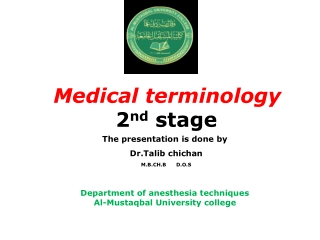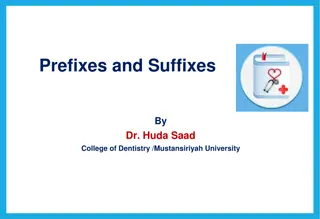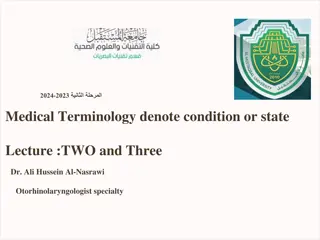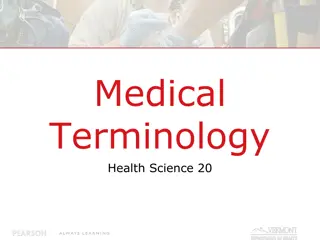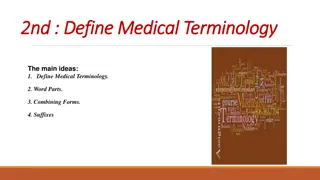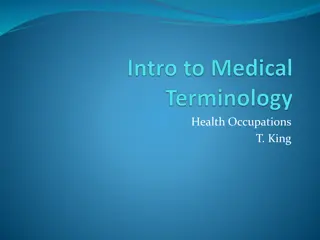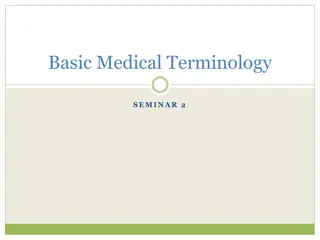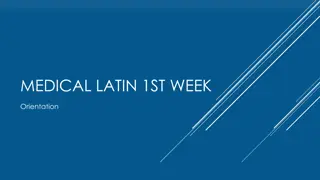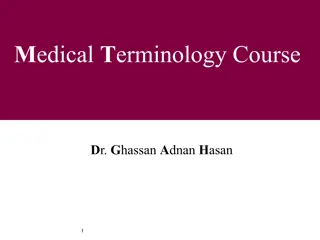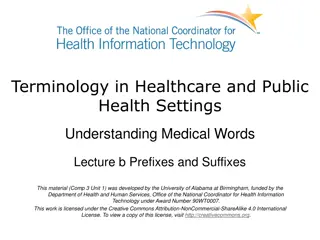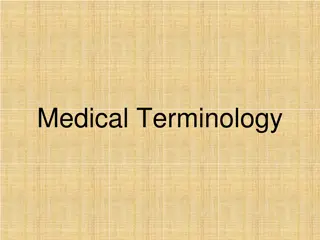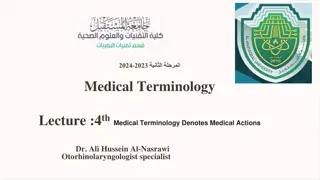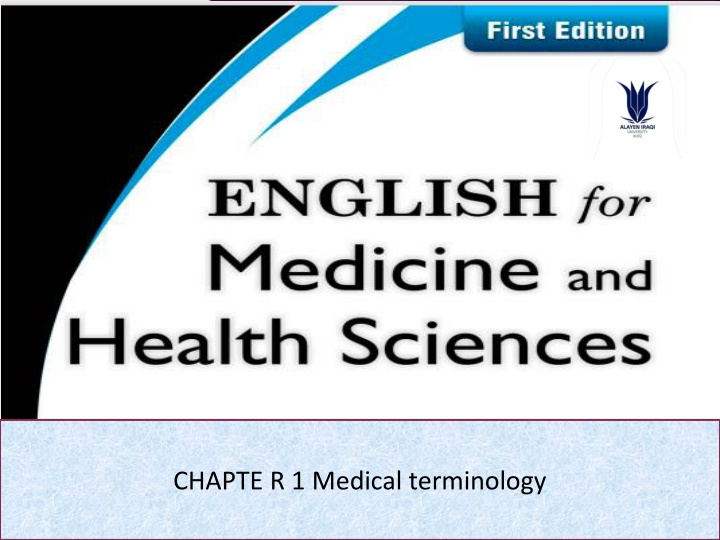
Medical Terminology Basics and Concepts
Understand the fundamental concepts of medical terminology, including terms related to diagnosis, prognosis, signs, symptoms, anatomy, physiology, and more. Explore the definitions of terms like lesion, inflammation, infection, tumor, syndrome, and acronyms in the medical field.
Download Presentation

Please find below an Image/Link to download the presentation.
The content on the website is provided AS IS for your information and personal use only. It may not be sold, licensed, or shared on other websites without obtaining consent from the author. If you encounter any issues during the download, it is possible that the publisher has removed the file from their server.
You are allowed to download the files provided on this website for personal or commercial use, subject to the condition that they are used lawfully. All files are the property of their respective owners.
The content on the website is provided AS IS for your information and personal use only. It may not be sold, licensed, or shared on other websites without obtaining consent from the author.
E N D
Presentation Transcript
LIST OF CONTENTS Review (What do you know about Terminology, Roots, suffixes, prefixes) Basic medical terms Focus on reading Home work
BASIC MEDICAL TERMS Diagnosis: The process of determining the nature and cause of a disease or injury through evaluation of patient history, examination, and review of laboratory data (state of complete knowledge). Prognosis: A prediction of the probable course and outcome of a disease (state of prior knowledge). Sign: Objective evidence of disease or the physical manifestation of injury, illness, or disease. Objective means that the sign can be evaluated or measured by the patient or others. Symptoms: Subjective evidence of disease or what the patient experiences about the injury; subjective means that it can be evaluated or measured only by the patient.
Anatomy :- is the science dealing with the form and structure of living organisms. Physiology :- is concerned with the systems and functions organs of the human body. Histology :- is study of the minute structure of cells, tissues, and organisms in relation to their function (microscopic anatomy). Embryology :- is the branch of biology and medicine concerned with the study of embryos and their development. lesion:- a pathologic change of the tissues to disease or injury Inflammation:- localized response to an injury or destruction of tissues Infection: the invasion of the body by a pathogenic organism Tumor: a swelling of a part of the body caused by an abnormal growth of tissue
Syndrome: A group of symptoms and signs that collectively indicate or characterize a disease, psychological disorder, or other abnormal condition. Acronym: A word formed by combining the initial letters of a multipart name or major parts of a compound term, such as GERD from Gastro Esophageal Reflux Disease. Abbreviation: A shortened form of a word used chiefly in writing to represent the complete form, such as AMI, for Acute Myocardial Infarction. Eponym: One whose name is the source of the name of something such as a disease, structure, operation, or procedure named for the person who discovered it first, for example, Marfan syndrome, Fallopian tube, Rinne test, Huntington disease.
o Acute disease: Rapid, severe, and of relatively short duration. Chronic disease: Lasting for a long period of time or marked by frequent recurrence, as certain diseases, may be controlled but almost never cured. Relapse: A return of a disease or its symptoms after partial recovery from it. Exacerbation: An increase in the severity of the disease or any of its symptoms. Remission: The period during which the symptoms of a disease abate or subside without having achieved a cure. Differential diagnosis: The differences between diseases in terms of clinical signs and epidemiological parameters; used as a basis for selecting as a diagnosis the one with the best fit to those seen in the subject. It is also known as to rule out (R/O).
Sarcoma: A cancerous tumor of fleshy tissue. Malignant: Cancer is tending to become progressively worse and to result in death; having the properties of an aplasia, invasiveness, and metastasis; said of tumors. You can also simply define it by a cancerous tumor that spreads like fire. Benign: Not malignant; not recurrent; favorable for recovery. You can also define it by a non-cancerous tumor that does not spread. Myocardial infarction (MI): Death of the cells of an area of the heart muscle as a result of oxygen deprivation, which in turn is caused by obstruction of the blood supply; commonly referred to as a heart attack. breath: (noun) air that flows in and out of lungs breathe: (verb) action of inhaling and exhaling
Read the following passage and answer the questions that follow. 1. Many of us owe more of a debt than we might suspect to the Islamic scientists of the Middle Ages. Muslim chemists, physicians, astronomers, mathematicians, geographers, and others not only kept alive the disciplines of Greek science but also extended their range, laying and strengthening the foundations on which much of modern science is built. Scientific terms with Arabic roots, from algebra to zenith, reflect a period when Islam s activity significantly widened knowledge and ameliorated human suffering. 2. Al-Razi, known in the west by his name Rhazes, one of the most celebrated of Islam s early physicians, lived from 865 to 925. His importance was so great that his colleagues called him the Experienced. The finest clinician of the age, he has been compared to Hippocrates for his originality in describing diseases. He is said to have written more than 200 books, ranging in subject matter from medicine and alchemy to theology and astronomy. About half the books are on medicine, including a well-known treatise on smallpox. In his discussion of smallpox, Al-Razi was the first to differentiate a specific disease from among many eruptive fevers that attacked man. By giving the clinical symptoms of smallpox, he enabled doctors to diagnose it correctly and to predict the course of the disease.
5. While Al-Razi knew nothing about bacteria, the theory of which was not to be discovered until the early seventeenth century, he had an instinctive sense of hygienic principles far ahead of medieval standards. To appreciate his insights, it must be remembered that he lived in a world where contamination and filth were so common as to go unnoticed, and infections and contagious diseases killed millions. Against this unsanitary background, he was once asked to choose the site for a new hospital in Baghdad. To do so, he suspended pieces of meat at various points around the city, and at the location where the meat decomposed most slowly, he recommended building the hospital. 6. The high point of Al-Razi s career was an encyclopedia in which he compiled Greek, Syrian, Persian, Hindu, and early Arabic knowledge, as well as anecdotal evidence based on his own extensive clinical experience. This book contributed a great deal to shaping European medicine.
5 .Another great Medieval Muslim physician was Ibn Sina, better known in the West by his Latin name, Avicenna. Called the Prince of Philosophers by his contemporaries, he is still recognized as one of the great minds of all times. He wrote some 170 books on various subjects and is said to have memorized the entire Qur an when he was only ten years old. Ibn Sina s most renowned achievement was the Canon of Medicine, an encyclopedia that dealt with virtually every phase of the treatment of disease. From the twelfth to the seventeenth centuries, it served as the chief guide to medical science in European universities. Ibn Sina is credited with such personal contributions as recognizing the contagious nature of tuberculosis and describing certain skin diseases and psychological disorders. He also observed that certain diseases can be spread by water and soil, an advanced view for his time. 6 Muslim physicians also helped develop the science of surgery and performed many remarkably complex operations for their time, including brain and blood vessel surgery and operations for cancer. Islamic physicians were especially skilled in treating eye diseases, perhaps because such ailments were so widespread in the Middle East. They wrote textbooks on ophthalmology and invented an ingenious method of operating on soft cataracts of the eye, using a tube to suck out the fluid that filled the capsule of the eye lens.
7. In the treatment of patients in hospitals, Muslims were progressive. As early as the start of the ninth century, there were thirty-four surprisingly modern hospitals throughout the Muslim world. Some of these hospitals had different wards for the treatment of different illnesses. They also had outpatient clinics for the immediate treatment of minor injuries, while patients with more serious complaints were admitted to a ward. In the eleventh century, peripatetic clinics served areas beyond the hospitals reach. These were moved from place to place on the backs of camels and were generally run by one or more doctors. These mobile clinics were also used in time of epidemics when hospitals were filled to overflowing HOME WORK Reading story and answer the following questions. 1. Name some early Arab and Muslim scholars. 2. In which fields did they excel? 3. Select a scholar and prepare a short oral presentation on his achievements.

